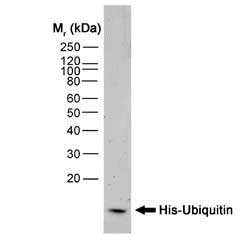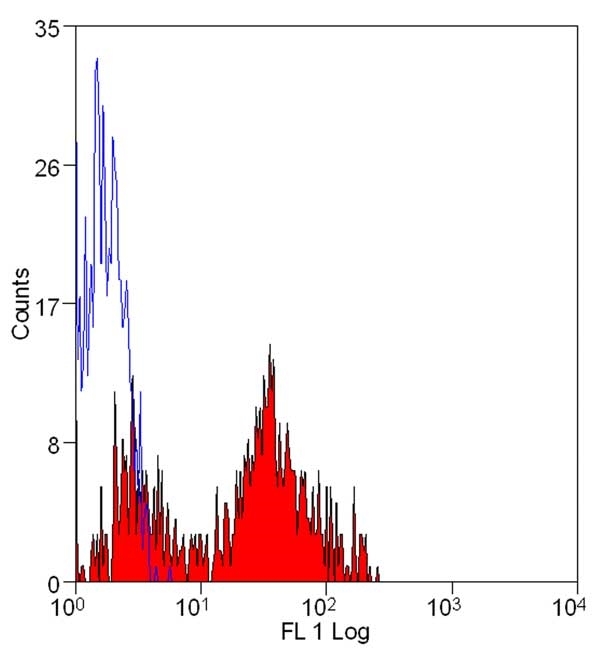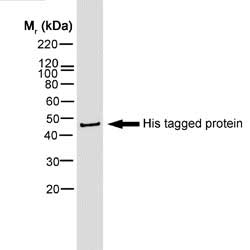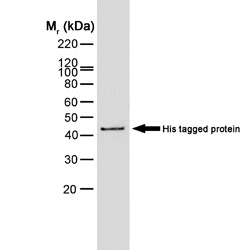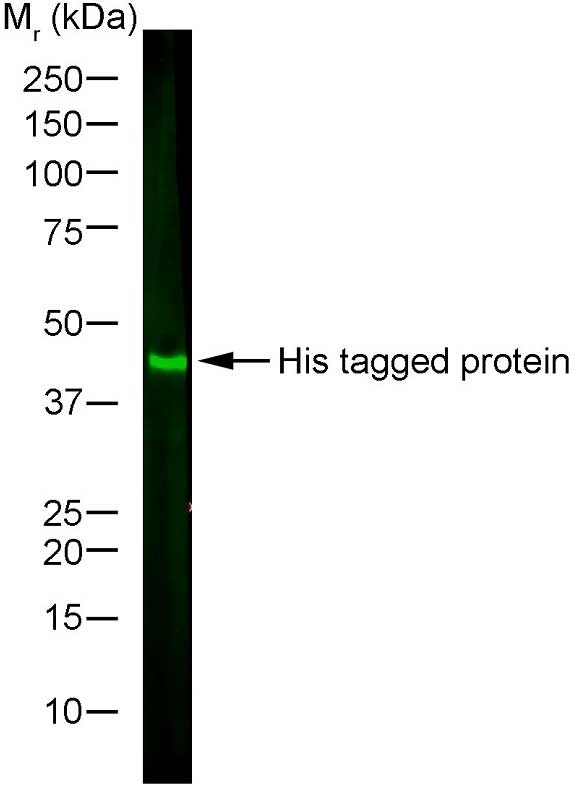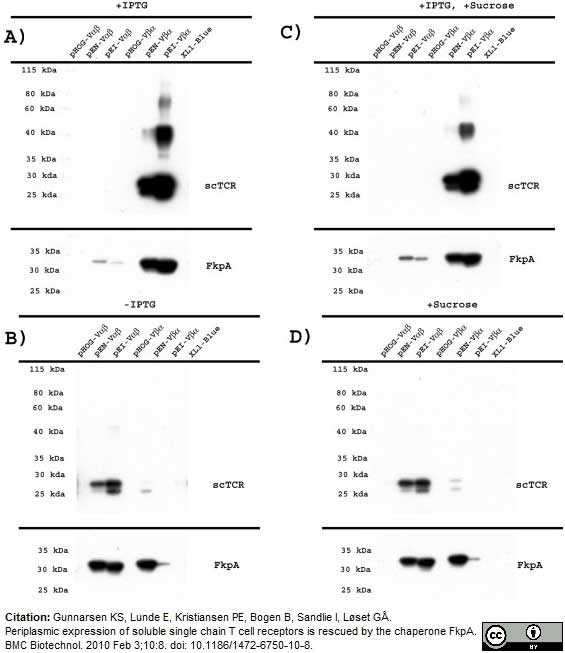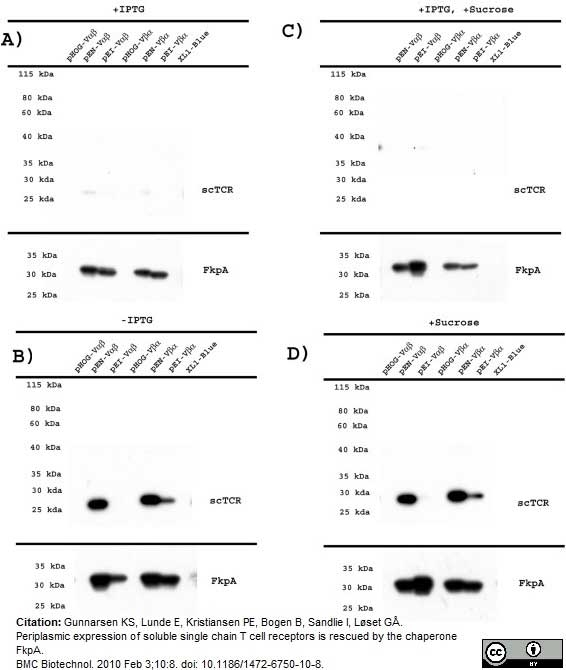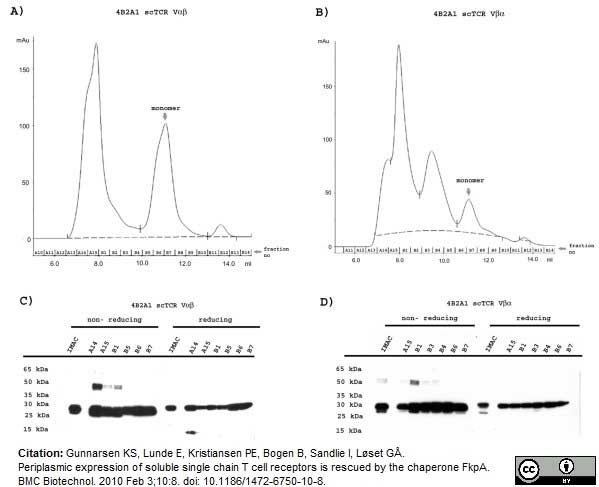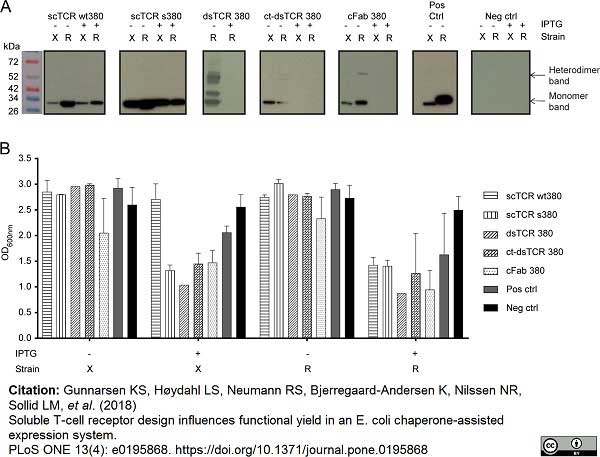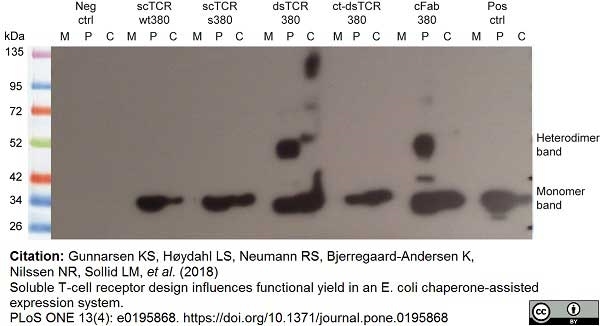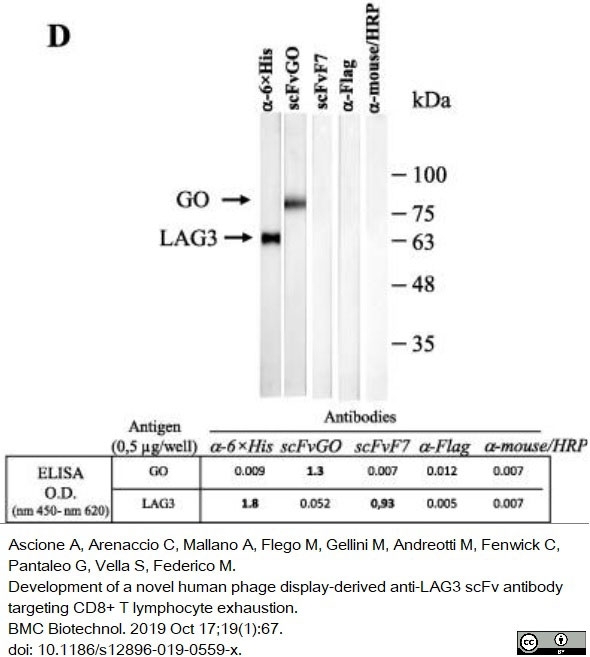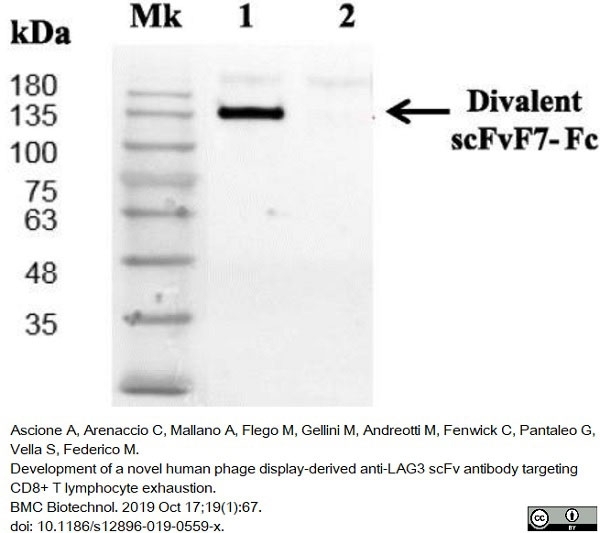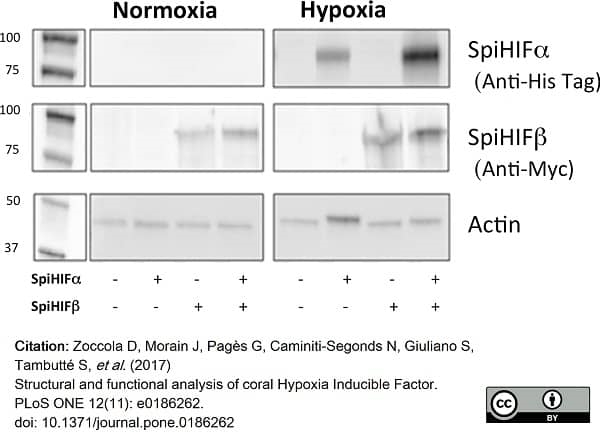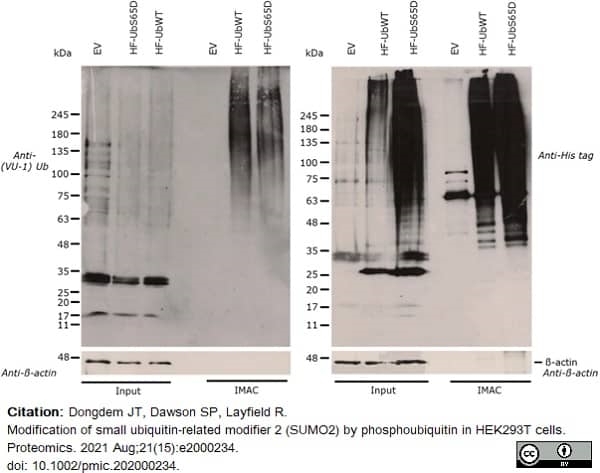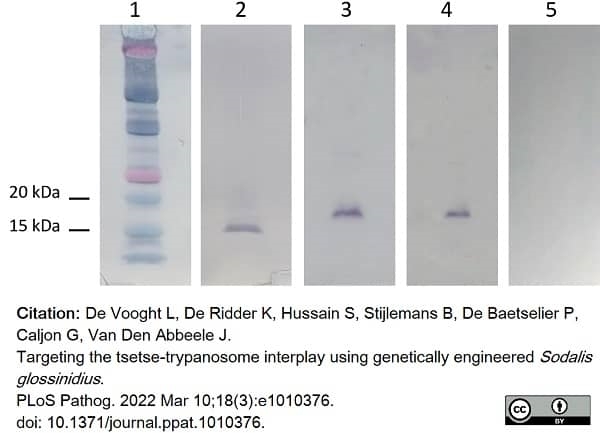Histidine Tag antibody | AD1.1.10















Mouse anti Histidine Tag
- Product Type
- Monoclonal Antibody
- Clone
- AD1.1.10
- Isotype
- IgG1
- Specificity
- Histidine Tag
| Mouse anti Histidine tag antibody, clone AD1.1.10 recognizes proteins and peptides containing the motif H-H-H-H-H-H and is therefore of value in detecting proteins containing histidine tags. Clone AD1.1.10 has been used to detect and purify histidine-tagged proteins expressed in mammalian ( In Western blotting of bacterial extracts the antibody has been shown not to cross-react with any endogenous products, although some cross-reactivity may be seen with extracts of insect or mammalian cells. This antibody is routinely tested in Western blotting on histidine tagged recombinant proteins and reacts against all histidine-tagged proteins so far tested. |
- Target Species
- Synthetic Peptide
- Product Form
- Purified IgG - liquid
- Preparation
- Purified IgG prepared by affinity chromatography on Protein A from tissue culture supernatant
- Buffer Solution
- Phosphate buffered saline
- Preservative Stabilisers
- 0.09% sodium azide (NaN3)
- Carrier Free
- Yes
- Immunogen
- PAX6 transcription factor linked to histidine tag.
- Approx. Protein Concentrations
- IgG concentration 1.0 mg/ml
- Fusion Partners
- Spleen cells from immunized Balb/c mice were fused with cells of the mouse NS1 myeloma cell line.
- Regulatory
- For research purposes only
- Guarantee
- 12 months from date of despatch
- Acknowledgements
- MCA1396GA, MCA1396: His-tag is a trademark of EMD Biosciences.
- MCA1396G: His-tag is a registered trademark of EMD Biosciences.
Avoid repeated freezing and thawing as this may denature the antibody. Storage in frost-free freezers is not recommended.
| Application Name | Verified | Min Dilution | Max Dilution |
|---|---|---|---|
| ELISA | |||
| Immunoprecipitation | |||
| Western Blotting | 1/500 | 1/1000 |
References for Histidine Tag antibody
-
Els Conrath, K. et al. (2001) Camel single-domain antibodies as modular building units in bispecific and bivalent antibody constructs.
J Biol Chem. 276 (10): 7346-50. -
Suen, J.L. et al. (2001) Characterization of self-T-cell response and antigenic determinant of U1A protein with bone marrow-derived dendritic cells in NZB x NZW F1 mice.
Immunol. 103: 301-309. -
Hoffmann, S.C. et al. (2007) Identification of CLEC12B, an inhibitory receptor on myeloid cells.
J Biol Chem. 282 (31): 22370-5. -
Zheng, J. et al. (2007) Serum from mice immunized in the context of Treg inhibition identifies DEK as a neuroblastoma tumor antigen.
BMC Immunol. 8: 4. -
Bahi, A. & Dreyer, J.L. (2008) Overexpression of plasminogen activators in the nucleus accumbens enhances cocaine-, amphetamine- and morphine-induced reward and behavioral sensitization.
Genes Brain Behav. 7 (2): 244-56. -
Wrighton, K.H. et al. (2009) Transforming Growth Factor {beta} Can Stimulate Smad1 Phosphorylation Independently of Bone Morphogenic Protein Receptors.
J Biol Chem. 284 (15): 9755-63. -
Diefenbacher, M. et al. (2011) The Dsl1 Tethering Complex Actively Participates in Soluble NSF (N-Ethylmaleimide-sensitive Factor) Attachment Protein Receptor (SNARE) Complex Assembly at the Endoplasmic Reticulum in Saccharomyces cerevisiae.
J Biol Chem. 286: 25027-38. -
Alvarez, M.M. et al. (2010) Specific recognition of influenza A/H1N1/2009 antibodies in human serum: a simple virus-free ELISA method.
PLoS One. 5: e10176.
View The Latest Product References
-
Bahi, A. et al. (2008) The role of tissue-type plasminogen activator system in amphetamine-induced conditional place preference extinction and reinstatement.
Neuropsychopharmacology. 33: 2726-34. -
Gunnarsen, K.S. et al. (2010) Periplasmic expression of soluble single chain T cell receptors is rescued by the chaperone FkpA.
BMC Biotechnol. 10: 8. -
Hwang, H.Y. et al. (2008) Highly specific inhibition of C1q globular-head binding to human IgG: a novel approach to control and regulate the classical complement pathway using an engineered single chain antibody variable fragment.
Mol Immunol. 45: 2570-80. -
De Vooght, L. et al. (2012) Expression and extracellular release of a functional anti-trypanosome Nanobody® in Sodalis glossinidius, a bacterial symbiont of the tsetse fly.
Microb Cell Fact. 11: 23. -
Saerens, D. et al. (2004) Single domain antibodies derived from dromedary lymph node and peripheral blood lymphocytes sensing conformational variants of prostate-specific antigen.
J Biol Chem. 279 (50): 51965-72. -
Than, N.G. et al. (2014) Evolutionary origins of the placental expression of chromosome 19 cluster galectins and their complex dysregulation in preeclampsia.
Placenta. 35 (11): 855-65. -
Elders RC et al. (2014) Recombinant canine IgE Fc and an IgE Fc-TRAIL fusion protein bind to neoplastic canine mast cells.
Vet Immunol Immunopathol. 159 (1-2): 29-40. -
Chin, S.E. et al. (2015) Isolation of high-affinity, neutralizing anti-idiotype antibodies by phage and ribosome display for application in immunogenicity and pharmacokinetic analyses.
J Immunol Methods. 416: 49-58. -
Peyrassol, X. et al. (2016) Development by Genetic Immunization of Monovalent Antibodies (Nanobodies) Behaving as Antagonists of the Human ChemR23 Receptor.
J Immunol. 196 (6): 2893-901. -
Kim H & Loparo JJ (2016) Multistep assembly of DNA condensation clusters by SMC.
Nat Commun. 7: 10200. -
Borg M et al. (2014) A novel interaction between Rab7b and actomyosin reveals a dual role in intracellular transport and cell migration.
J Cell Sci. 127 (Pt 22): 4927-39. -
De Meyer, T. et al. (2015) Comparison of VHH-Fc antibody production in Arabidopsis thaliana, Nicotiana benthamiana and Pichia pastoris.
Plant Biotechnol J. 13 (7): 938-47. -
Siddiqui AA et al. (2015) Humoral immune responses to a recombinant Plasmodium vivax tryptophan-rich antigen among Plasmodium vivax-infected patients and its localization in the parasite.
Appl Biochem Biotechnol. 175 (4): 2166-77. -
Warnecke, A. et al. (2017) Nitration of MOG diminishes its encephalitogenicity depending on MHC haplotype.
J Neuroimmunol. 303: 1-12. -
Bertucci, A. et al. (2011) A new coral carbonic anhydrase in Stylophora pistillata.
Mar Biotechnol (NY). 13 (5): 992-1002. -
Boujon, C.L. et al. (2017) Development and validation of an immunohistochemistry procedure for the detection of a neurotropic bovine astrovirus.
J Virol Methods. 239: 26-33. -
Cartwright, S.P. et al. (2017) Rapid expression and purification of the hepatitis delta virus antigen using the methylotropic yeast Pichia pastoris.
BMC Res Notes. 10 (1): 340. -
Thanongsaksrikul, J. et al. (2018) Identification and production of mouse scFv to specific epitope of enterovirus-71 virion protein-2 (VP2).
Arch Virol. 163 (5): 1141-1152. -
Gunnarsen, K.S. et al. (2018) Soluble T-cell receptor design influences functional yield in an E. coli chaperone-assisted expression system.
PLoS One. 13 (4): e0195868. -
Ascione, A. et al. (2019) Development of a novel human phage display-derived anti-LAG3 scFv antibody targeting CD8+ T lymphocyte exhaustion.
BMC Biotechnol. 19 (1): 67. -
Zoccola, D. et al. (2017) Structural and functional analysis of coral Hypoxia Inducible Factor.
PLoS One. 12 (11): e0186262. -
Kimura, K. et al. (2021) Overexpression of human BAG3P209L in mice causes restrictive cardiomyopathy.
Nat Commun. 12 (1): 3575. -
Dongdem, J.T. et al. (2021) Modification of small ubiquitin-related modifier 2 (SUMO2) by phosphoubiquitin in HEK293T cells.
Proteomics. 21 (15): e2000234. -
Chuang, H.C. et al. (2021) Effect of cell-permeable grouper Manganese Superoxide Dismutase on environmental stress in fish.
Protein Expr Purif. 187: 105951. -
Cheng, C.M. et al. (2021) Heterologous expression of bacterial CotA-laccase, characterization and its application for biodegradation of malachite green.
Bioresour Technol. 340: 125708. -
De Vooght, L. et al. (2022) Targeting the tsetse-trypanosome interplay using genetically engineered Sodalis glossinidius..
PLoS Pathog. 18 (3): e1010376. -
Minami, S.A. et al. (2022) Production of novel SARS-CoV-2 Spike truncations in Chinese hamster ovary cells leads to high expression and binding to antibodies.
Biotechnol J. 17 (9): e2100678. -
Chen, Y.J. et al. (2023) A non-genetic engineering platform for rapidly generating and expanding cancer-specific armed T cells.
J Biomed Sci. 30 (1): 35. -
Boudkkazi, S. et al. (2023) A Noelin-organized extracellular network of proteins required for constitutive and context-dependent anchoring of AMPA-receptors.
Neuron. 111 (16): 2544-56.e9. -
Nguyen, H.M. et al. (2023) Heterologous expression and characterization of a MoAA16 polysaccharide monooxygenase from the rice blast fungus Magnaporthe oryzae
Electronic Journal of Biotechnology. 66: 1-16. -
Rossey, I. et al. (2021) A vulnerable, membrane-proximal site in human respiratory syncytial virus F revealed by a prefusion-specific single-domain antibody.
J Virol. 95 (11): e02279-20. -
Khosravi, M. et al. (2016) Canine Distemper Virus Fusion Activation: Critical Role of Residue E123 of CD150/SLAM.
J Virol. 90 (3): 1622-37. -
Tamaki, Y. et al. (2024) Shiga toxin type 2 B subunit protects mice against toxin challenge when leashed and bundled by a stable pentameric coiled-coil molecule.
Vaccine. Feb 15 S0264-410X(24)00129-4. [Epub ahead of print]. -
Kimura, T. et al. (2024) Quantification of lipoprotein lipase in mouse plasma with a sandwich enzyme-linked immunosorbent assay.
J Lipid Res. 65 (4): 100532.
- RRID
- AB_322084
Please Note: All Products are "FOR RESEARCH PURPOSES ONLY"
View all Anti-Synthetic Peptide ProductsAlways be the first to know.
When we launch new products and resources to help you achieve more in the lab.
Yes, sign me up